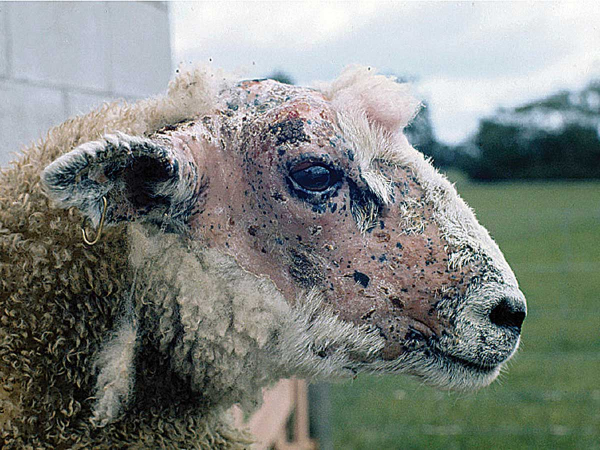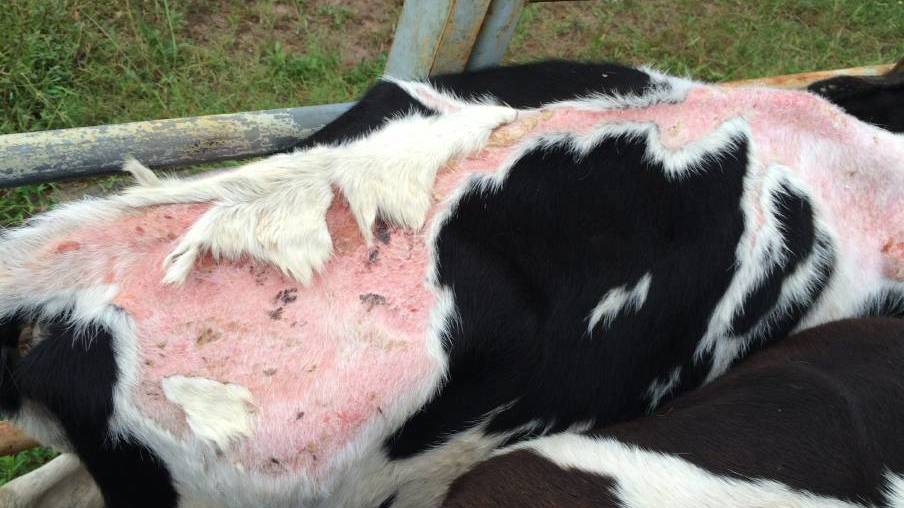What is Facial Eczema?
Facial eczema or “Photosensitisation” is a type of sunburn affecting exposed areas of pale skin in livestock. Although it can present as a skin disease, in most outbreaks most animals show few obvious signs of skin lesions but will be suffering from liver damage affecting their production and growth.
While it occurs more commonly in cattle and sheep, it can also occur in goats and alpacas.
Causes
Facial eczema is caused by the ingestion of the sporidesmin toxin of the Pithomyces chartarum fungi. This toxin, produced by fungi, can be found growing on decaying plant material. Late summer and early autumn tend to have higher humidity and milder temperatures at night which give rise to the rapid growth of spores. Rapid growth of the fungus occurs shortly after warm rains during this period. While the fungus and subsequently the toxin can be found on many plant species, it is more likely to occur on perennial ryegrass pastures because of its high quantity of dead plant matter. When facial eczema occurs, it tends to be present in multiple animals at once rather than a single case. Once exposed to the toxin, clinical signs will generally present within 10-14 days.
Signs of Facial Eczema
There are several signs that affected animals may exhibit. These include:
- Seeking shade
- Skin lesions
- Affected skin peeling
- Photosensitisation
- Dermatitis
- Jaundice
- Depression
- Death
Facial eczema can be presented on unpigmented skin as photosensitisation which occurs as a secondary symptom to liver damage.
Production effects associated with facial eczema and liver damage can include:
- Reduced milk production
- Wool loss
- Poor growth
Influences
There are several factors that can influence the occurrence and toxicity of toxin production and occurrence of facial eczema. These include:
- Spore concentration
- Pasture height (higher spore concentration at base)
- Amount of dead plant material present in paddocks
- Amount of spores and toxin ingested (factors into severity)
Ingesting one large dose can be just as toxic and harmful to the animal as ingesting several smaller doses over a prolonged period.
Prevention and Management
To prevent facial eczema from occurring, management should be implemented months in advance of the likely occurrence period. There are two main preventatives that can be applied: grazing management and administration of zinc.
By applying good grazing management practices early, spore growth and exposure can be minimised regardless of the favorable seasonal conditions. Aiming to have adequate paddock numbers for rotational grazing to avoid overgrazing pastures and having animals consuming short feed which is more likely to have a higher spore concentration. If rotational grazing is not possible, aiming to avoid short feed in pastures and reducing stocking rates should be considered. Clover dominant pastures aid in reducing favorable conditions for spore growth and can reduce the risk of facial eczema from occurring. Additionally, the application of a fungicide prior to the risk season has also been implemented as an effective measure to reduce spore development and growth. Pastures will remain safe for 6 weeks after which spraying should be repeated.
Zinc supplementation to animals has also been used as a preventative measure against facial eczema. The zinc neutralizes the toxin in the body by forming a complex with it. There are several ways zinc can be given to animals: in the water source, feed ration, as an oral drench, or a bolus. The most effective option tends to be the bolus which provides a slow release of zinc. This option, unlike some of the others, ensures that each animal is receiving an adequate amount of zinc.
Monitoring spore counts during favorable conditions can ensure proactive treatment if spore counts begin trending upwards. Instruction on how to sample pastures and be downloaded here.
Treatment
While the above measures are effective to prevent facial eczema and subsequent liver damage, they must be enforced prior to ingestion.
As ingestion of the toxin causes photosensitisation through liver damage, much of the treatments are similar to prevention. Removing affected stock from the affected paddock should be done as soon as possible and they should be kept out of direct sunlight while they recover. For photosensitisation cases associated with liver damage, green feed in the diet should be limited and instead hay should be increased. Additionally, stressful husbandry activities should be minimised through the recovery.
Further Resources
- MSD Vet Manual – Facial eczema in animals
- Agriculture Victoria – Seasonal conditions favour facial eczema
- NRE Tasmania – Facial eczema
- Dairy Australia – Facial eczema
Click here to download a PDF version.
For further information, please contact the VFF Stock Sense team on 1300 882 833 or by email [email protected]

